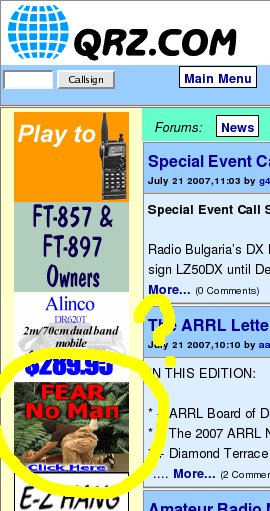Ham radio’s ability to set up ad hoc communications networks that are immune to natural disasters and jamming is legendary. Rightly so, I add. However, it disappoints me that so much ham radio recruiting has turned to this as a selling point…be a ham, carry an HT, be a HERO (a HERO…a HERO…a hero…a hero—if you don’t get this, it’s from a long-forgotten episode of the Simpsons.) Of course, in this time of “war on terror” (“terror” is not a state and therefore does not deserve capitalization) and heroism and emergency preparedness are all the rage. Why should ham radio be any different?
When I was in high school, I spent my summers working at a two-way radio shop. We installed and maintained the public service communications equipment for the surrounding towns and the county as a whole. This was an enlightening experience on many levels…I learned some of my most important troubleshooting skills at that job. But, another thing that I recall is the sheer enormity and robustness of the systems, especially for 911 and dispatching. I’m sorry; but, ham radio has nothing on these guys. It’s organized and has better back-up power , redundancy, and lightning protection than 95% of hams. And, I’m talking about a rural county with a population less than 40000.
So, what about disasters that destroy or disable this sort of sophisticated system? I’m glad you asked. The efficacy of ham radio as a communication resource is heavily rooted in its ability to self-organize and self-deploy…flexibility and technical competence. Have you been to your local radio club meeting lately…or listened to your local repeater lately? Flexibility isn’t exactly the first word that comes to mind.
The technical competence of the average ham has been declining since commercial equipment was first available, probably in the 1920’s. When I see and hear about some “go-kits” and “emergency comm centers” that have been built, I shake my head. An FT-817 to a screwdriver antenna does not an emergency communication system make. Sure, they look pretty and professional. But, trust me; when the poop jumps off, I’ll be the guy with the communications-grade transceiver using full-sized antennas.
And then there’s the paramilitary types. The genesis of this blog entry was the following ad on QRZ.com. Advertising, even on the Internet, costs money. Somebody thought that hams were an important part of this market. Note that the other ads on the site are almost exclusively about ham radio. It’s like the old Sesame Street game, “Which one does not belong?”

Self-organize, self-deploy, and self-defend? Right. If you want to serve your country in this way, you should be in the National Guard or the military. If they don’t want you, there’s probably a good reason for that.
Anyhow, the point of all of this is not to point fingers at those who are interested in emergency communications. Rather, step back and evaluate what you’re doing. Playing the emergency communications card repeatedly is not sustainable. Do we really want a ham population that’s gung ho on emergency communications but has no other skills or interests in the hobby? My primary interest is contesting; and I’ll be the first to say that I’m glad not every ham is a contester! Think about that one.